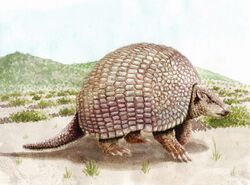Biology:Pampatherium
| Pampatherium | |
|---|---|

| |
| Scientific classification | |
| Domain: | Eukaryota |
| Kingdom: | Animalia |
| Phylum: | Chordata |
| Class: | Mammalia |
| Order: | Cingulata |
| Family: | †Pampatheriidae |
| Genus: | †Pampatherium Ameghino, 1875[1] |
| Species | |
| |
Pampatherium is an extinct genus of xenarthran that lived in the Americas during the Pleistocene. Some species went extinct right at the Pleistocene-Holocene border.
Distribution
Pampatherium humboldtii and P. typum lived in South America (mostly Brazil ) during the Pleistocene, with P. humboldtii surviving into the very Late Pleistocene.[2][3][4]
Pampatherium mexicanum was the only North American species, reaching as far north as Sonora, Mexico. It lived during the Rancholabrean.[5]
Description
Pampatherium resembled a very large armadillo. One species, P. humboldtii, weighed up to 209.5 kg (462 lb).[6] Pampatheres generally resembled armadillos, particularly in the shape of it skull, long snout, and the presence of three areas on the carapace (movable bands, scapular and pelvic shields). Among the features that distinguish them from armadillos are their posterior teeth, which are bilobate rather than peg-like. Their endocranial morphology is also similar to glyptodonts.[6]
The osteoderms of Pampatherium have little ornamentation, lack a depressed marginal band, and those from the posterior buckler are mostly rectangular.[7]
Pampatherium is thought to have excavated paleoburrows and would have both fought with and have been preyed upon by Arctotherium angustidens in these dens.[8]
References
- ↑ "Pampatherium". BioLib. https://www.biolib.cz/en/taxon/id675343.
- ↑ Varela, L. (2018). "Potential Distribution of Fossil Xenarthrans in South America during the Late Pleistocene: co-Occurrence and Provincialism". Journal of Mammalian Evolution 25 (4): 539–550. doi:10.1007/s10914-017-9406-9.
- ↑ Ferreira, T. (2018). "Pampatherium humboldtii (Lund, 1839) (Xenarthra, Cingulata) of the Southern Brazilian Quaternary: cranial anatomy and taxonomic remarks". Revista Brasileira de Paleontologia 21 (2): 158–174. doi:10.4072/rbp.2018.2.06.
- ↑ Guerra, C.C; Mahecha, G.A (1983). "Pampatherium paulacoutoi, a new species of giant armadillo from Bahia, Brazil (Ledentata, Dasypodidae)". Revista Brasileira de Zoologia 2 (4). doi:10.1590/S0101-81751983000400003.
- ↑ Mead, J.I. (2007). "Late Pleistocene (Rancholabrean) Glyptodont and Pampathere (Xenarthra, Cingulata) from Sonora, Mexico". Revista Mexicana de Ciencias Geológicas 24 (3): 439–449. https://www.academia.edu/2218365.
- ↑ 6.0 6.1 Tambusso, P.S.; Farina, R.A (2015). "Digital endocranial cast of Pampatherium humboldtii (Xenarthra, Cingulata) from the Late Pleistocene of Uruguay". Swiss Journal of Palaeontology 134: 109–116. doi:10.1007/s13358-015-0070-5.
- ↑ Edmund, A . Gordon (1996). A review of Pleistocene giant armadillos (Mammalia, Xenarthra, Pampatheriidae).
- ↑ Soibelzon, Leopoldo H.; Pomi, Lucas H.; Tonni, Eduardo P.; Rodriguez, Sergio; Dondas, Alejandro (1 September 2009). "First report of a South American short-faced bears' den (Arctotherium angustidens): palaeobiological and palaeoecological implications". Alcheringa: An Australasian Journal of Palaeontology (Taylor & Francis Online) 33 (3): 211–222. doi:10.1080/03115510902844418. https://www.tandfonline.com/doi/full/10.1080/03115510902844418. Retrieved 1 January 2023.
Wikidata ☰ Q1119613 entry
 |

